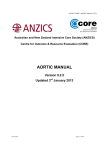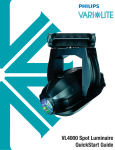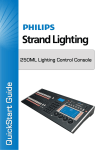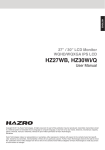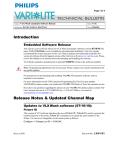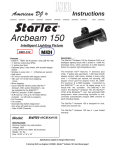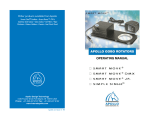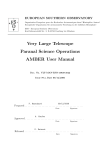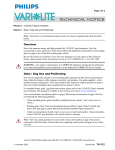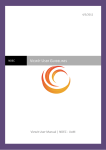Download here - Carallon
Transcript
AUTOMATED-LIGHTING DATA SERVICE – OVERVIEW 07 September 2011 Introduction Modern automated lighting controllers require information about the fixtures they are controlling. This lets them present the user with appropriate controls for these fixtures. At its most basic it is a mapping between features of the fixture and the DMX512 control protocol (eg. Pan is on channel 3, range 0 to 255, default value 127), but it can stretch to thumbnails of gobos and effects fitted to the fixture, or the physical dimensions so a console can display a correctly scaled icon. Currently many control manufacturers compile this data in their own proprietary formats. This is a significant amount of work for support staff due to the number of fixtures on the market, the rate at which new fixtures are introduced, and the different formats that fixture manufacturers release the information in. Each control manufacturer requires essentially the same data however, so this effort in gathering it is being duplicated many times over. Carallon operates a service to provide this fixture data in a standard format to controls manufacturers on a subscription basis. The data is stored in an XML format so it is easy for them to extract the information they need, and it has been divided into a number of distinct sections so users only need to subscribe to sections that contain relevant information for their controller. This data is available to subscribers on fair and reasonable terms intended to make the service convenient and cost effective while protecting this valuable data resource. This service is now used by some of the most well-known control manufacturers in the industry. The libraries generated from it are used in consoles and controllers in many different market sectors, and many different hardware configurations. Available Services The different sections available as parts of the subscription service are as follows: Section A – Fixture Personalities This section includes the core data required to identify and control each fixture. It presents the DMX512 behaviour of the fixture in a standard format. This is separated into DMX channels and ranges, and gives the corresponding behaviours (features) of the fixture for each of those ranges. Each channel the fixture uses is defined, as is each DMX value within that channel. This allows the personality to be used for visualiser applications, as well as for controllers. The syntax gives additional information, such as whether a DMX range represents a discrete setting or a continuous range. Interactions between channels are also recorded, and where one channel controls the mode of another then each mode is separately defined. There is a naming convention for features that is common across all fixtures in the database. This also records the relationship between features, eg that Gobo Index and Gobo Rotate actually control the same mechanism. Real world information about the fixture is included in the personality where specified in the fixture documentation. This might be the pan and tilt range (in degrees), strobe rates (in Hertz) or gobo index angles (in degrees). We also include the names of the colours, gobos, and effects fitted to the various wheels of the fixture, where specified in the documentation. This allows the controller to use a generic fixture model. Note that as this information is based solely on manufacturer supplied documentation, we cannot make any assurances concerning its accuracy. We aim to test each fixture after writing, and so verify the information in the personality. Testing is dependent on the availability of the fixtures though, so we cannot provide any assurances as to when a particular fixture will be tested. Additional data within the personality categorises the fixture in various ways, for example the type of fixture (luminaire, accessory, controller), the light source (incandescent, discharge, LED, etc), the movement capabilities (static, moving mirror, moving yoke, etc). These may be used by the controller, for example to select an appropriate icon for the fixture. User notes and known issues are also embedded in the personality, which specify DIP switch or menu settings required to select that personality, plus other useful information. These could also allow a controller to provide help information for the fixtures. If a fixture has more than one DMX mode then the mode is specified within the personality, and, at our discretion, we will include separate personalities for the different modes. We also indicate whether a particular personality is solely based on manufacturer data or has been tested as well. This section includes the RDM IDs for the fixture. Further information can be added to the database at the request of subscribers provided: (i) there is a clear rule set for determining the value of an attribute; (ii) we can make the attribute and that rule set openly available to all subscribers; and (iii) it is understood that we cannot immediately add that attribute to fixtures already in the database, it will take some time. Section B – Graphical Data This section includes data that may be required by control systems offering a graphical user interface. For each fixture it includes thumbnails of the gobos, effects, and animation wheels present as standard in each fixture and colour swatches for the dichroics and gels. Each gobo has been classified, so suitable replacements can be chosen if swapping one type of fixture for another. B1 – Gobo libraries This section is an additional option for subscribers to Section B. It consists of libraries of gobos, effects, and animation wheels from gobo manufacturers, rather than those fitted to any specific fixture. The database includes the Rosco and Apollo gobo libraries, and we are talking to other manufacturers about licensing their libraries. This subsection is available at no cost to clients who subscribe to section B. Additional licensing terms are required however to protect the manufacturer’s IP. Section C – Colour Mixing Data This section contains the data to control the colour mixing systems of different types of fixture. This information is not available from manufacturer’s literature so fixtures and gels must be calibrated before we can include them in the database. There are different formats available which allow different levels of colour control by consoles. C1 – Gel to CMY lookup This option consists of a lookup table per colour mixing fixture, which lists each gel and light source we have calibrated, together with the corresponding CMY values for that fixture. This will allow a user to select a gel and source, and then set their colour-mixing lights to a matching colour regardless of the type of fixture. The data can be used without any knowledge of colour spaces or any specialised implementation in the control system. It will allow different types of fixture to match the colours of particular gels, but the fixtures will not necessarily follow the same colour path as they fade between two colours. To do that requires more sophisticated colour data, such as that in sections C2 or C3 C2 – Colour mixing data – Client defined format We can also provide individual tables defining the colour response of each fixture type in a client specified colour space and data format. It could also includes data for each gel and light source in the corresponding format. The client will need to write their own algorithms to use this data within their control system, and this will require an understanding of colour spaces. There are many colour spaces and formats which this data can be presented in, so it is up to the client to decide which one is most appropriate for their console. This will depend on what capabilities they want it to have. There is a one off payment to cover the cost of implementing and testing the algorithms to convert data into the custom format. C3 – Colour mix data – Carallon defined format With this option we provide individual tables defining the colour response of each fixture, gel and light source in formats that we define. This will allow a colour mixing fixtures to match the colour of a given gel, of another colour mixing fixture, or of a colour picker. It will also allow different types of fixture to follow the same colour path as they fade between the same colours. To use this data within a control system requires a Carallon supplied algorithm for conversion and interpolation. There is a one off payment to cover the cost of this algorithm. Section D – Visualisation Models This section is intended to include the specific modelling data required by visualisation tools to define their virtual fixtures. The data requirements in this area are still being developed. Please contact us for details or to give input on your data collection needs. Release Cycle The data is released to subscribers in two ways: The entire database is released to subscribers via a dedicated FTP site on a regular release cycle. Each such release includes the latest versions of all the database files that each subscriber is entitled to (by virtue of the sections they have subscribed to) together with all supporting documentation. Each release includes all the personalities that have been written since the previous release. There are 9 releases per year, usually on a six week cycle, but this may vary slightly, for example to avoid clashes with major trade shows or public holidays. Between releases, subscribers can request a personality for a fixture that an end user has asked for – typically because it is needed for an event on a particular date. In this case we will just send the additional files that are needed for that particular request. It should be noted that we cannot accept requests from end users directly, because we cannot generate console personalities ourselves, all such requests must come via the subscribers technical support team for the console/controller. Conversion to client format The personalities in the database should not be used directly in controllers. XML is quite a verbose form of storage, and not all of the information that they include about a fixture will be needed by a particular controller. We therefore expect subscribers to convert them into a more compact, relevant, format to use in their controller. The converter will need to extract the relevant information from each personality, using rules to decide what is wanted and what to ignore. We include a set of software routines in each release which gives access to the information in personalities. Our subscribers can use them within their convertor to help this first stage. The converter can then process the information it has extracted, and store it in a suitable format for its associated controller. The converter could have several additional tasks. The controller may have certain constraints (memory available for the fixture library for example, or colour mixing systems it can control) so the converter could be set up to filter out individual personalities, entire fixtures or fixtures with a particular characteristic (an unusable colour mixing system for example). It could also be set up to map feature names - “Colour” to “Color” for example. The rules used by the converter to extract and modify the information from the database will depend on the format that the controller requires, and on its particular capabilities, requirements, and constraints. We are not party to these factors, so are not able to write the converter. We are more than happy to advise on conversion strategies however, and include some ideas in the database user manual. Fixture Schedule Adding new fixtures is an ongoing process as manufacturers launch new luminaires, as we add older luminaires, and as we test and calibrate existing ones. There will never be a date on which our data library is ‘complete’ therefore. We already have over 5500 personalities for over 2500 fixtures by 200 manufacturers. We also have some 4000 gobo thumbnails and 1200 gels in the database. Pricing The billing cycle for the subscription service is quarterly (every 3 months). There is a minimum sign-up period of one year. When subscribing to multiple data sections packages may be available. Please contact us for a quote at [email protected]. Product Development Kit For control products that are currently in development we have a scheme to allow you access to fixture data, documentation and support for development purposes only, without incurring a fee every quarter. You pay a one-off fee equivalent to a single quarter’s subscription for the sections you require and we will provide fixture data for a representative sample of approximately 30 fixtures covering all the typical test cases. We nominate a set of personalities which include all the syntax used in the database, and you may nominate some - for example because you have access to them for testing. This data can be used throughout the development phase (however long that may take). It can also be included in beta releases of the software, for testing purposes only, provided it is not made available for sale. Once the product is released then you must upgrade to the full subscription to continue using the data, and at that time we will make the rest of the database available. Terms and Conditions This is not designed as a consumer service, but as a customized service to a relatively small fraternity of product manufacturers. Consequently all aspects of the service are open to discussion and it is our aim to work with subscribers to tailor the service to their needs. This document provides an overview of the planned service and all details are subject to change. The following is intended only to give a general outline of our terms and conditions. The full licence agreement is available for review on request. – All data is provided under licence and remains the property of Carallon Limited. – The licence grants use of the data for a specified list of products agreed with Carallon Limited. As a guide, an acceptable list of products covered by a single list might include: (i) a family of products that use a common library format; or (ii) a primary product (or family of products) that is under active development and one or more products (or families of products) that are being maintained but not actively developed. It is our intent that a single manufacturer will normally require a single licence, but in certain cases where multiple distinct product lines exist then separate licences may be required. – The data is made available to subscribers for use in the specified products only. The subscriber shall not make the data available to any third-party (other than an end-user of their product in the appropriate format for use in the product, see below) or use it for any other purpose than creating libraries for the specified products. – The list of products covered by a licence may be changed at any time by agreement with Carallon Limited. This agreement will not normally be withheld providing the guidelines given above continue to be met. (For example a new product within the same product family is being developed, or a new product family is being developed and existing products will now be maintained only.) – A single licence may cover control products or visualiser products but not both. Separate licences are required when a product range includes both types of product. Exceptions may be made on a case by case basis where the visualization is not a distinct product but only exists as a part of a control product. – The minimum subscription period is one year. On signup to the service payment for the first two quarters shall be made in advance. After the first two quarters all subscription payments shall be invoiced at the start of the respective quarter and paid within 30 days. – All subscribers will have access to updates covering new fixtures or retested fixtures as they become available. – All subscribers are entitled to support from Carallon Limited regarding fixture data issues specifically. This support will be provided to employees and representatives of the subscriber only. Carallon cannot provide support or assistance to end users of our subscribers’ products at any time. – All products that have been named on the licence for a full year acquire indefinite rights to use of the data even if the subscription later lapses (although will clearly lose entitlements to the updates and support under the subscription service). We recognise that it is not realistic to ask for a subscription commitment for the lifetime of a product and so asking for at least one year of subscription from the last addition of a product to the licence seems like a reasonable compromise. Obviously we hope that subscribers will choose to continue the service in order to receive ongoing support and updates, but should they choose not to then they will be fully entitled to continue using the data in their existing products (though not in any new products). – All data will be accurate to the best of our knowledge. However we can make no absolute guarantee about the accuracy of our data and our liability for any defects is strictly limited to correction of the errors in a timely fashion once brought to our attention. – We may be unable, in rare circumstances, to provide colour mixing data for certain subtractive colour mixing systems used in fixtures. The main fixtures this applies to are the Varilite VL5 series and derivatives. Further details are available on request. – As part of our support service we will endeavour to respond to subscriber requests for particular fixtures to be added to our library or to be tested. However our ability to test fixtures depends upon the availability of the fixture, which is not under our control. – Subscribers must make best efforts to ensure that they do not distribute libraries for their products in a format that releases Carallon’s proprietary data into the public domain. It is imperative that the data be distributed in a format that is not human-readable and cannot be trivially reverse-engineered to gain access to Carallon’s data. For each product a sample of a compiled product library should be made available to Carallon for approval prior to general distribution, such approval not to be unreasonably withheld or delayed.




